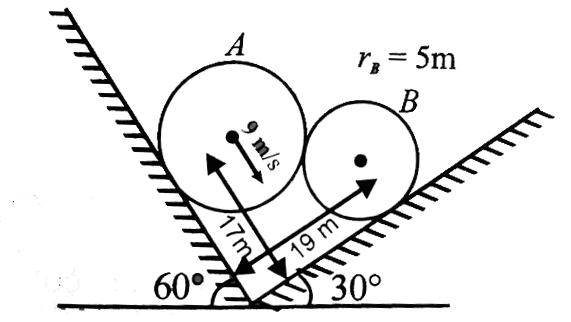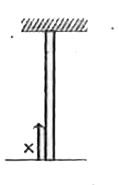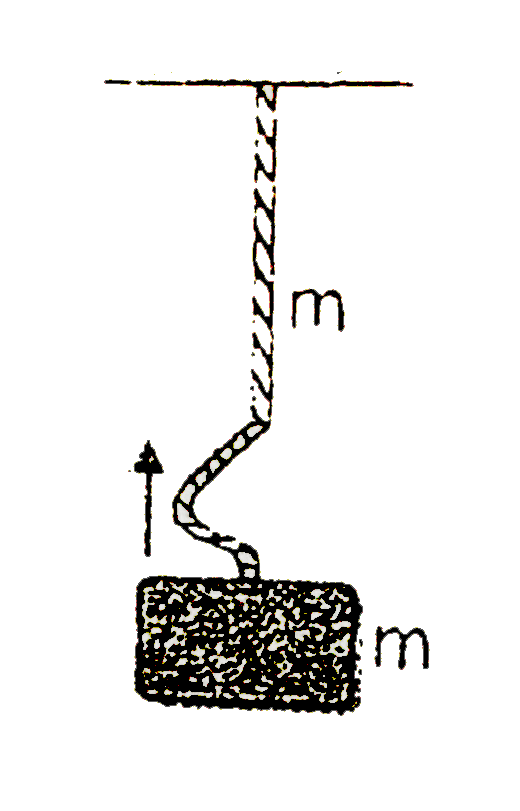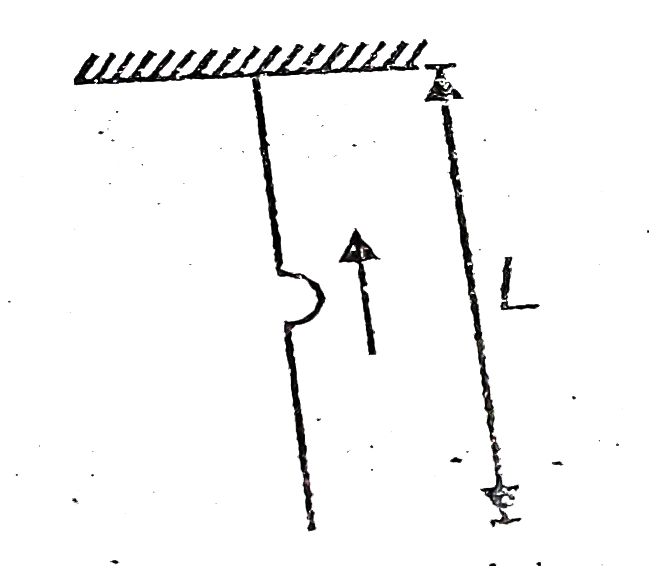A wire of length L, is hanging vertically from a rigid support. If a transverse wave pulse is generated at the free end of wire then which of the following statement is wrong
Velocity at bottom end is zero
Velocity at top end is √gL
Time taken to reach the top end is 2√Lg
Acceleration of wave is g
The correct Answer is:D
To solve the problem, we need to analyze the statements regarding the behavior of a transverse wave pulse generated in a vertically hanging wire. Let's go through the statements one by one to identify which one is incorrect.
Step 1: Analyze the first statement
Statement: Velocity at the bottom end is 0.
- At the bottom end of the wire, the displacement (x) is 0 because it is fixed to a support.
- The velocity of the wave can be expressed as v=√g⋅x.
- Substituting x=0 gives v=√g⋅0=0.
Conclusion: This statement is correct.
Step 2: Analyze the second statement
Statement: Velocity at the top end is √g⋅L.
- At the top end of the wire, the displacement (x) is equal to the length of the wire (L).
- Using the same formula for velocity, we have v=√g⋅L.
Conclusion: This statement is also correct.
Step 3: Analyze the third statement
Statement: Time taken to reach the top end is 2√Lg.
- The time taken for the wave to travel the length of the wire can be calculated using the formula t=Lv.
- Substituting v=√g⋅L, we get t=L√g⋅L=√L2g⋅L=√Lg.
- However, this is the time for the wave to travel to the top, not double that value.
Conclusion: This statement is incorrect.
Step 4: Analyze the fourth statement
Statement: Acceleration of the wave is g.
- The relationship between velocity and displacement is given by v2=g⋅x.
- Differentiating with respect to time gives 2vdvdt=gdxdt.
- Using dxdt=v, we can express acceleration a as a=dvdt=g2v.
- This indicates that the acceleration is not equal to g but rather g2.
Conclusion: This statement is also incorrect.
Final Conclusion
The statement that is wrong is the one regarding the time taken to reach the top end, which is incorrectly stated as 2√Lg. The correct time is √Lg.
Summary of the Incorrect Statement
- Incorrect Statement: Time taken to reach the top end is 2√Lg.
Statement: Velocity at the bottom end is 0.
- The velocity of the wave can be expressed as v=√g⋅x.
- Substituting x=0 gives v=√g⋅0=0.
Conclusion: This statement is correct.
Statement: Velocity at the top end is √g⋅L.
- Using the same formula for velocity, we have v=√g⋅L.
Conclusion: This statement is also correct.
Statement: Time taken to reach the top end is 2√Lg.
- Substituting v=√g⋅L, we get t=L√g⋅L=√L2g⋅L=√Lg.
- However, this is the time for the wave to travel to the top, not double that value.
Conclusion: This statement is incorrect.
Statement: Acceleration of the wave is g.
- Differentiating with respect to time gives 2vdvdt=gdxdt.
- Using dxdt=v, we can express acceleration a as a=dvdt=g2v.
- This indicates that the acceleration is not equal to g but rather g2.
The statement that is wrong is the one regarding the time taken to reach the top end, which is incorrectly stated as 2√Lg. The correct time is √Lg.
- Incorrect Statement: Time taken to reach the top end is 2√Lg.
Topper's Solved these Questions
- WAVE MOTIONBOOK - AAKASH SERIESCHAPTER - WAVE MOTIONEXERCISE - LECTURE SHEET (EXERCISE-II (LEVEL-II(ADVANCED) STRAIGHT OBJECTIVE TYPE QUESTIONS))
6 Videos
- WAVE MOTIONBOOK - AAKASH SERIESCHAPTER - WAVE MOTIONEXERCISE - LECTURE SHEET (EXERCISE-II (LEVEL-II(ADVANCED) MORE THAN ONE CORRECT ANSWER TYPE QUESTIONS))
4 Videos
- WAVE MOTIONBOOK - AAKASH SERIESCHAPTER - WAVE MOTIONEXERCISE - LECTURE SHEET (EXERCISE-I (LEVEL-II(ADVANCED)MATRIX MATCHING TYPE QUESTIONS))
1 Videos
- UNITS AND MEASUREMENTSBOOK - AAKASH SERIESCHAPTER - UNITS AND MEASUREMENTSEXERCISE - EXERCISE -3
66 Videos
- WAVE MOTION AND SOUNDBOOK - AAKASH SERIESCHAPTER - WAVE MOTION AND SOUNDEXERCISE - PROBLEMS (LEVEL - II)
97 Videos
Similar Questions
A metal wire of length L is suspended vertically from a rigid support. When a bob of mass M is attached to the lower end of wire, the elongation of the wire is l:
View SolutionA string is hanging from a rigid support. A transverse
pulse is excited at its free end. The speed at which the
pulse travels a distance x is proportional to
View SolutionA Uniform rope having mass m hags vertically from a rigid support. A transverse wave pulse is produced at the lower end. The speed v of wave pulse varies with height h from the lower end as
View SolutionA uniform rope of length 12 m and mass 4 kg is hung vertically from a rigid support transverse wave pulse is produced at lower end. The speed of the wave pulse al x = 2.5 m from lower and will be kg=10 m/s)
View Solution
System is shown in the figure. Velocity of sphere A is 9 ms. Find the speed of sphere B.
View SolutionA string is hanging from a rigid support. A transverse wave pulse is set up at the bottom. The velocity v of thr pulse related to the distance covered by it is given as

View SolutionA uniform rope of elngth l and mass m hangs vertically from a rigid support. A block of mass m is attached to the free end of the rope. A transverse pulse of wavelength λ is produced at the lower end of the rope. The wavelength of the pulse, when it reaches the top of the rope. is aλ. Find a2

View SolutionA thick uniform rope of length L is hanging from a rigid support. A transverse wave of wavelength λ0 is set up in the middle of the rope. The wavelength of the wave as it reaches the top most point is

View SolutionA uniform rope of legnth L and mass m1 hangs vertically from a rigid support. A block of mass m2 is attached to the free end of the rope. A transverse pulse of wavelength λ1 is produced at the lower end of the rope. The wavelength of the pulse when it reaches the top of the rope is λ2. The ratio λ2λ1 is
View SolutionA uniform rope of length 12 mm and mass 6 kg hangs vertically from a rigid support. A block of mass 2 kg is attached to the free end of the rope. A transverse pulse of wavelength 0.06 m is produced at the lower end of the rope. What is the wavelength of the pulse when it reaches the top of the rope?
View Solution
